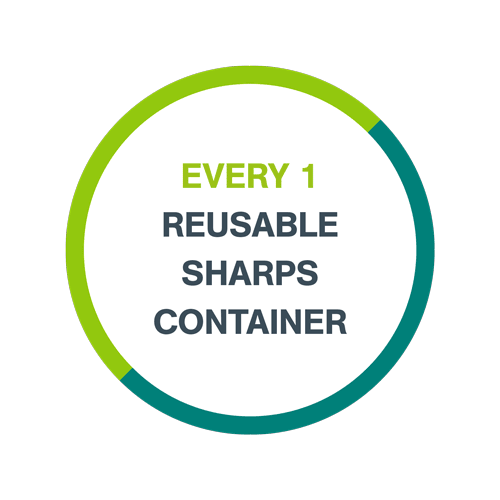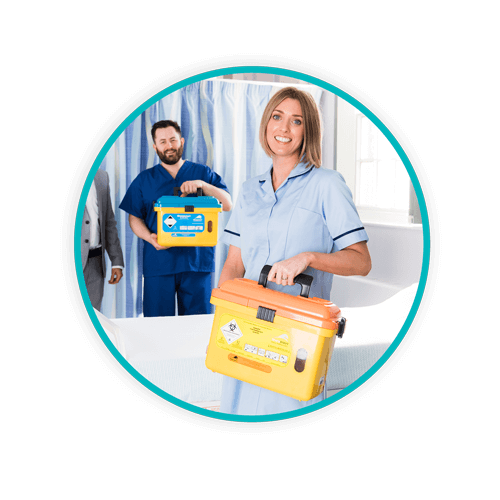Single-Use Plastic Reduction Strategies for Healthcare
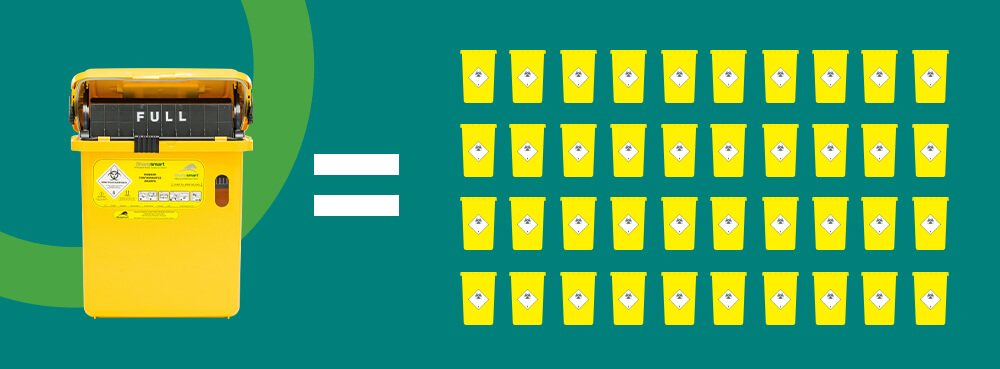
Are you running out of ideas for reducing single-use plastics in your facility? With the Net Zero deadline looming ever closer, you may be starting to worry…
We’ve got you covered. Join us as we delve into all things plastic and provide five practical single-use plastic reduction strategies that you can easily implement.
TOPICS WE WILL COVER:
1 / The Problem with Plastics in Healthcare
2 / Single-Use Plastics and the Waste Hierarchy
3 / Strategies to Reduce Single-Use Plastics in Healthcare
4 / Sharpsmart: Your Partner in Single-Use Plastic Reduction
5 / Reduce Your Reliance on Single-Use Plastics Today
The Problem with Plastics in Healthcare
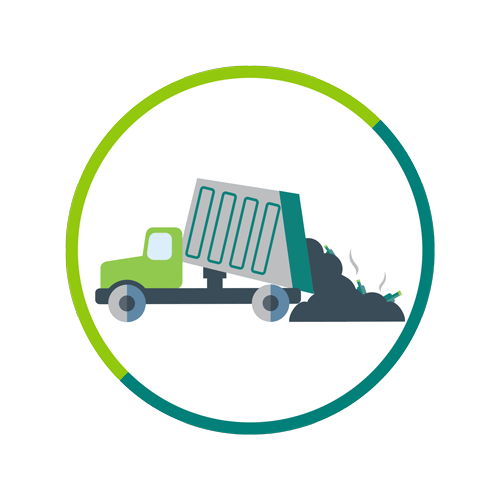
There can be no doubt that plastic has enabled enormous progress in healthcare – sterility, safety, and convenience are all benefits we’ve come to rely on. But the widespread use of single-use plastics has become a major problem. This reliance on throwaway plastic items has created a growing environmental and public health challenge.
In the NHS alone, single-use plastics account for 23% of all waste, much of which is incinerated at high temperatures, regardless of whether it was used in patient care. These plastics are rarely recyclable, often over-packaged, and contribute significantly to the healthcare industry’s carbon footprint.
The environmental impact of single-use plastics is clear:
- They take hundreds of years to decompose in landfill.
- Incineration releases greenhouse gases and toxic emissions.
- Most plastics are made from fossil fuels, contributing to climate change from the moment they’re produced.
Single-use plastics used in the healthcare setting also have an economic impact – the costs associated with their purchase and disposal can quickly add up.
As healthcare systems work towards Net Zero goals, reducing single-use plastic is no longer optional – it’s essential.
Single-Use Plastics and the Waste Hierarchy
To truly appreciate the impact of single-use plastics as a waste material, it’s essential to understand their position in the waste hierarchy.
Understanding the Waste Hierarchy
The waste hierarchy is a framework that ranks the most environmentally friendly ways to manage waste. It consists of the following steps, listed in order of priority from most to least favourable:
1. Prevention: Reducing the amount of waste generated altogether.
2. Correctly Segregate: Ensuring that generated waste is correctly segregated by waste stream.
3. Recirculate/Reuse: Reusing items instead of disposing of them after one use.
4. Recycle: Transforming waste materials into a new substance or product.
5. Generate for Energy Sources: Using waste to generate energy and recover other resources such as water, heat, material, and nutrients.
6. Disposal: Sending waste to high-temperature incinerators or alternative treatment facilities.
7. Landfill: Landfilling secures waste in a single location, but there’s limited capacity. It also contributes to harmful greenhouse gas emissions.
Using the waste hierarchy as a guide can help you and your organisation make the most environmentally responsible decisions when managing waste to minimise the impact it’s having.
For a deeper dive, see our blog – What Is the Waste Hierarchy?
Where Are Single-Use Plastics in the Waste Hierarchy?
Single-use plastics rank near the bottom of the waste hierarchy. They’re designed for disposal, not sustainability, and as they’re not easily recycled, they’re considered one of the least environmentally friendly waste types. They do not adhere to the principles of preventing or reducing waste, conserving resources, or minimising environmental impact. Instead, they contribute to environmental degradation and waste, with their effect far from sustainable.
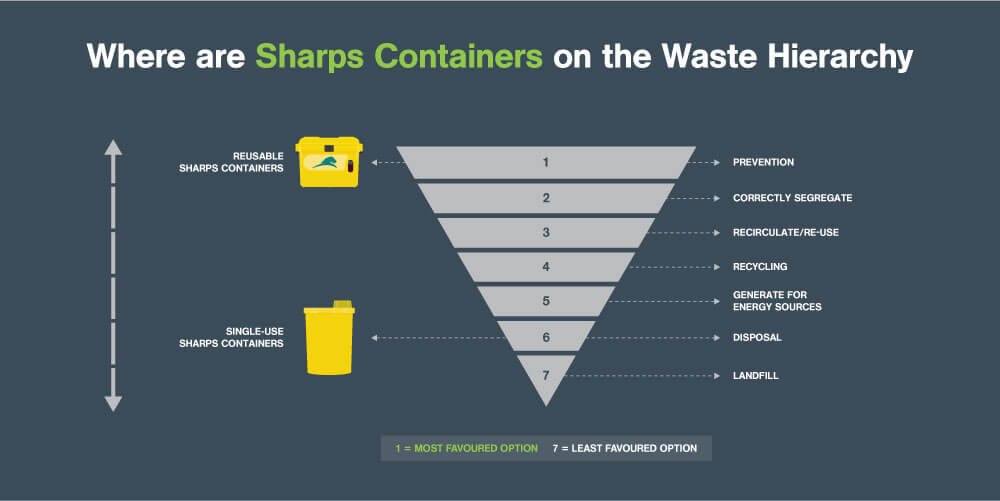
Strategies to Reduce Single-Use Plastics in Healthcare
At Sharpsmart, our understanding of healthcare waste covers far more than reusable sharps containers alone, so we didn’t want to make this all about them – even if ours are clinically proven to be the world’s safest…
Here are five strategies to reduce single-use plastics in your facility.
1. Embed Sustainability into Procurement
Procurement is one of the most powerful levers for change. By embedding sustainability criteria into purchasing decisions, healthcare organisations can reduce plastic waste at the source.
What this looks like in practice:
- Prioritising reusable or multi-use products where clinically appropriate.
- Selecting suppliers that offer minimal or recyclable packaging.
- Including environmental impact assessments in tender evaluations.
- Collaborating with vendors to redesign products for circularity.
- Working with suppliers to implement take-back schemes for used products.
Implementing changes like these not only reduces waste, but they also show that your organisation is serious about sustainability and that it’s a priority, not just another box to tick.
2. Switch to Reusable Sharps Containers
One of the most impactful changes a healthcare facility can make is switching from single-use disposable to reusable sharps containers.
Sharpsmart’s reusable containers are:
- ISO-compliant and clinically engineered for safety.
- Sanitised to achieve a high level of disinfection and reused up to 500 times.
- Clinically proven to reduce needlestick injuries by up to 87%.
- Arrive pre-assembled as a fully managed service that improves efficiency.
- Not only sustainable for the first few uses, they have a positive environmental impact across the full lifecycle.
Our reusable containers also reduce the frequency of container exchanges, saving staff time and reducing unnecessary movement. Over time, they offer significant cost savings and a measurable reduction in environmental impact.
Reusables align with the waste hierarchy’s principles of prevention and reuse by eliminating the need for single-use plastics entirely.
3. Change Clinical Behaviours and Culture
Reducing single-use plastic isn’t just about products – it’s about people and practices. This means that a simple product cull won’t be enough. One of the most overlooked sources of waste is the premature opening of single-use items. Once opened, even if unused, the item becomes waste.
How can you address this?
- Encourage a shift from ‘just in case’ to ‘confirm required’ preparation.
- Train staff to assess clinical need before opening items.
- Promote awareness of the environmental impact of over-preparation.
This behavioural shift will require leadership, education, and reinforcement. Clinical teams should be empowered to question long-standing habits and encouraged to adopt a more intentional approach to resource use.
As Richard Hixson notes in his guest-authored blog – The Hidden Cost of Plastic in Healthcare:
‘One of the most important decisions a healthcare professional can make is when to open the packaging of a single-use device.’
4. Improve Waste Segregation and Disposal
The simple fact is this: single-use plastic cannot be totally removed from the healthcare environment. But even when single-use plastics are necessary, how they’re disposed of can make a big difference.
There are many items incorrectly classified as infectious and sent for high-temperature incineration when they could be safely managed through the offensive waste stream or even recycling.
Steps to improve segregation:
- Provide clear signage and colour-coded bins.
- Train staff on correct waste classification.
- Audit waste streams to identify misclassification.
- Challenge outdated practices that default to incineration.
It’s also important to note that correct classification and segregation not only reduce emissions, but also lower your disposal costs.
5. Support Innovation and Circular Design
Even though some single-use plastics are currently unavoidable, innovation is key to reducing their long-term impact.
What to look for:
- Products designed for reuse or recyclability (remembering that reuse is higher up the waste hierarchy than recycling).
- Bioplastics or materials with lower toxicity.
- Suppliers committed to circular economy principles and with a transparent Carbon Reduction Plan.
You can also support innovation by:
- Participating in pilot programmes for sustainable products.
- Providing feedback to suppliers on product design.
- Including sustainability metrics in supplier evaluations.
By supporting manufacturers and suppliers to make the necessary single-use devices more sustainable, perhaps through lighter materials, reduced packaging or take-back schemes, you can still drive progress.
Sharpsmart: Your Partner in Single-Use Plastic Reduction
Traditional waste companies turn up to collect waste bins and containers from the waste hold, and that’s as far as they go… We do things differently from other waste companies. We go further.
At Sharpsmart, we’re dedicated to providing a compliant, safe, and efficient cradle-to-grave healthcare waste management service. And we don’t just turn up at your waste compound to collect waste – we work within the four walls of your facility to drive the outcomes you want and achieve your goals.
Here are some aspects of the Sharpsmart Difference:
A True Partnership – We’re easy to work with! You’ll have a direct point of contact and a contract with no hidden fees – only pay for what you need.
Lowered Costs Through Efficiency – We’ll help you identify efficiencies through proper waste stream identification, right-sizing containers, and an appropriate service frequency.
An Easy Transition – Change is easy with us! From contract setup to installation and service frequency, we’ll guide you through it.
Tailored Service Frequency – Having your collections too often, so your bins are never full, or too infrequently, forcing you to use the wrong containers, is a problem we eradicate.
Proven Customer Satisfaction – We consistently deliver on time and in full (99.33% DIFOT), and our existing partners are pleased to recommend us to others (National NPS score of 66).
Easy to Get in Touch – No call centres or robots, you’ll have direct contact with a local team of Customer Excellence Agents and your dedicated Contract Manager.
All of that on top of our 24+ years of healthcare waste experience, which you can leverage to your benefit.
Reduce Your Reliance on Single-Use Plastics Today
As we’ve seen, single-use plastics pose a significant problem in healthcare, with substantial environmental, economic, and health impacts. Reducing single-use plastic isn’t about perfection – it’s about progress. From procurement to clinical practice, every decision counts.
Whether it’s switching to reusable sharps containers, rethinking what gets opened in theatre, or challenging outdated waste practices, the path to sustainable healthcare starts with small, intentional steps.
If you’re looking for ways to improve your environmental impact and reach your targets on the route to Net Zero, don’t hesitate to get in touch.
Let's Talk!
Your time is valuable, and we don’t want to play hard to get. You can either phone us directly on the details listed on our contact page, or feel free to fill out this short form and one of our team members will get back to you as quickly as possible.
